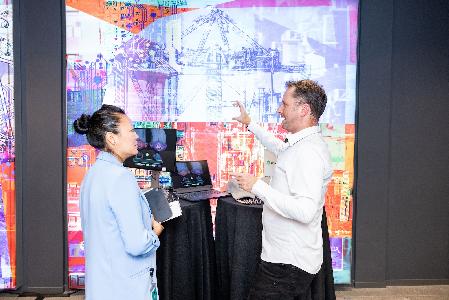While large cities like New York and Los Angeles continue to be the stereotypical hubs for aspiring influencers, smaller markets like Pittsburgh are carving out a space.
The rise of influencer marketing means local content creators can make their dream careers possible. Like other cities, Pittsburgh influencers’ incomes depend on authenticity and engagement, while still facing an unstable market. Living in a mid-sized city, however, offers more chances to connect for smaller brand deals and make money on the creative endeavor.
“Creating content is my form of art,” Pittsburgh-based influencer Alaina Wodarek, who goes by @alaina_wodarek on Instagram, told Technical.ly. “It’s the balance of creativity and business strategy that makes being an influencer such a unique and fulfilling entrepreneurial journey.”
Not only is it creating new entrepreneurs, but it’s also greatly impacting the already established ones. Influencer marketing provides an in for startups, small businesses and other members of the innovation economy to connect directly with the followers who already make up their target markets.

The industry of influencer marketing is expected to be worth $24 billion by the end of this year, according to media company Influencer Marketing Hub’s annual report. As the influencer marketing industry continues to grow, some market analysts project the broader creator economy could exceed $500 billion by 2030.
How is this possible? People are increasingly turning to social media to discover new products and make purchasing decisions, said Deanna Tomaselli, vice president of the Motherhood Inc., a communications agency that specializes in connecting brands to content creators.
For businesses, social media is often the first point of contact it has with customers, acting as the brand’s “front door,” Tomaselli said at a recent innovation roundtable event in Pittsburgh. “Influencers are part of the neighborhood.”
According to the companies themselves, it’s working. About 98% of industry leaders believe creators are better than traditional marketing, according to this year’s State of Creator Marketing Report from software company CreatorIQ.
The keys to creator success? Authenticity and engagement
Aspiring content creators see the growth of influencer marketing as a sign that a career on social media can be both a legitimate entrepreneurial path and fulfilling work.
Pittsburgh-based creator Nicole Young, known as @nicoleyoungtech, turned to content creation after leaving her job at a local tech startup right before the pandemic. She’s gained over 60,000 followers across Instagram and YouTube since 2020. Young’s content centers around career advice, digital literacy and tips on productivity or organization.
“I knew about influencer marketing when I started and was interested in that,” Young told Technical.ly. “That influenced how I created content and how I tried to position myself.”

Within the first year, brands paid Young to make sponsored content for her audience, primarily women of color in tech or those aspiring to enter the field. She said she’s tried to be strategic with the paid work she’s done, focusing on sponsors that align with her values because she feels a responsibility to provide genuine value to her followers.
“My experience at the startup was that I was the only African American woman, and that was very isolating,” Young said. “So, a lot of what my [YouTube] channel was focused on was trying to make tech accessible to people who looked like me.”
Working with companies that don’t align with a creator’s brand can undercut the message and erode trust with the audience, one of the most valuable things creators can offer businesses looking to try influencer marketing.
For businesses, the authentic connection content creators have with their followers can be a powerful tool to promote products or services more effectively, said Brenasia Ward-Caldwell, a tech and lifestyle content creator living in Pittsburgh with a similar audience to Young’s. The potentially cheaper price tag of influencer marketing can be a plus as well.
“Companies have realized that you can touch so many different types of audiences for less, which has never been able to happen until influencer marketing,” Ward-Caldwell, who goes by @c0debre, said. “Some people will take free work because they feel valued.”
Even creators with great content can miss out on their full earning potential if they don’t know their worth, though. That’s why Ward-Caldwell suggests creators do market research and value engagement analytics — such as likes, comments and shares — over follower count.
Both creators and brands alike see engagement as a key indicator of trust and influence in a saturated market where “community lasts longer than virality,” Ward-Caldwell said.
“You can buy followers easily,” she said. “It’s easy to inflate that, so what you really want to show is your impact.”
Despite success, the creator economy is still a rocky industry
While influencing can seem lucrative from the outside, like any business endeavor there are risks.
For most influencers, the business can be feast or famine, said Wodarek, who began posting fashion and lifestyle content as a hobby in college and now has an LLC for the entrepreneurial venture.
While big cities like New York and Los Angeles come to mind for high-profile influencers, smaller markets like Pittsburgh offer unique perks. There are more opportunities to work with local startups and small businesses, as well as national brands.
While that could provide more streams of income, it doesn’t always mean more money, according to Wodarek.
“Some projects could be worth $3,000, while others $200, and some brands pay the next day, while some take net 90,” Wodarek said. “My salary is different every month.”
It can mean preparing for unexpected pitfalls, like losing access to an account, apps being banned or even certain sites falling out of popularity. Wodarek has turned to complementary business endeavors to combat instability in her industry, including modeling, creating a custom journal for her followers and alternative media forms, like newsletters or podcasting, to reach new audiences.
Some creators, like Ward-Caldwell, a senior security advisor at Microsoft, also keep their full-time jobs for stability — and to keep their content authentic and unique.
“I’m very intentional about making sure I balance both,” Ward-Caldwell said, as the tech knowledge she shares on her social media is how she creates “space to pour back into the community.”
Before you go...
Please consider supporting Technical.ly to keep our independent journalism strong. Unlike most business-focused media outlets, we don’t have a paywall. Instead, we count on your personal and organizational support.
Join our growing Slack community
Join 5,000 tech professionals and entrepreneurs in our community Slack today!

Why Pittsburgh is known for robotics, and where it’s going next

This exec spent 30 years at one company, and thinks more people should do the same

AI in action: How InsightFinder AI and Robin AI transform IT and legal workflows at major organizations



